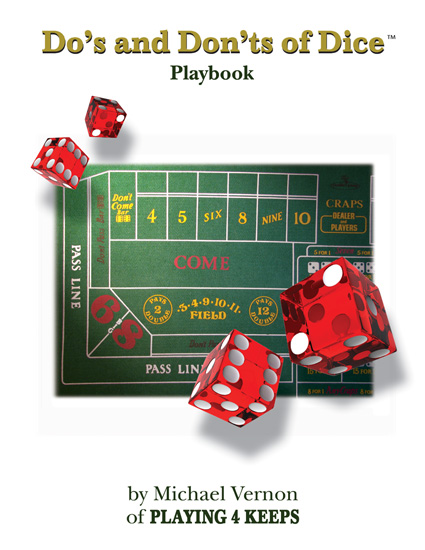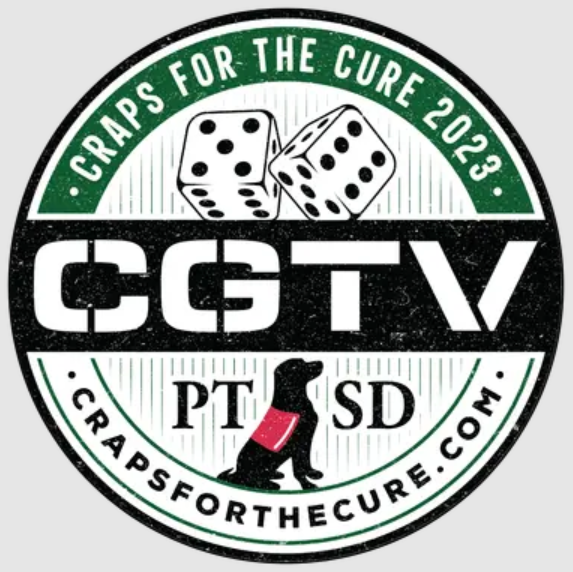|
Number Control
BY: Mike in Hawaii
We talked about Dice Control and a believable, learnable mechanism for it, axial control.
But it is very important to remember two things. First that dice control, when it works, directly influences the 36 possible rolls of the pair of dice. Second, Craps is not played with the numbers on the dice, it is played with the sum of the two numbers on the dice. A set of 11 numbers, 11 sums. Dice control only indirectly influences these numbers. To get any beneficial control of the Game of Craps, you must translate dice control into number control.
True there are hop bets that focus on individual pairs of numbers. And there are hard ways, which are only made one way. But the basic flow of the game moves on the sums, the 11 totals from 2 to 12.
If you look at a roulette wheel casually, you may be impressed with the random arrangement of the numbers. But as you look more closely you discover that it is a wonderfully engineered piece of equipment. Nothing about its layout is random. Dice are the same way. The numbers are placed on each die with some important patterns.
By far the most important pattern is the "opposite sides total Seven" property. Select any side of a true casino die and notice the number on the top face. The bottom face when added to it will total Seven. There are in fact three pairs of numbers, like three sets of twin brothers, not identical twins, but twins. Seven's compliments of each other.
[1 and 6] [2 and 5] [3 and 4]
Each pair makes an "axis". They are locked together. If one is on top of the die, the other is guaranteed to be on the bottom, not just be one of the other five faces, but exactly the bottom face. No need to turn the die over. If five is on top, two is on the bottom. If not, someone is going to have a very serious talk with security and the boxman!
The six possible numbers on a given die also make a closed set of six faces. This is very important. If you use dice control to suppress one face, that is discourage it from ending up on top, you will encourage the other five faces to end up on top. The odds of the six faces appearing will always total 100%. Normally each will randomly appear on top, in the long run, 1/6th or about 16.67% of the time.
With axial control we are trying to discourage a pair of faces, an axis, from appearing on top. If you use axial control effectively to discourage the 1-6 horizontal axis, then you will encourage the other four faces. With axial control you encourage the other four faces equally. If you think you can control one of those four faces in addition to the pair of horizontal axial faces, that is what I call "Facial Control".
Even there, the dice construction limits what you can do with facial control. If you encourage five to be on top, the slack is not taken up by the other three non-axial faces. Any control that encourages the five to be on top, encourages the two to be on the bottom by the same amount. It has to. They are twins.
It is much harder to believe in Facial Control as a reality and a learnable skill. Also it is not at all clear that it would even be useful. Why? Because of the construction of a die.
More on that later. Now let's talk about mass.
Nope, we are not going to church and pray for more Naturals and fewer Seven Outs. I mean the "weight" of each of the 11 numbers in Craps.
The heaviest number is Seven. It can be made six ways. The lightest numbers are two and 12 which can only be made one way each.
2 and 12 = 1
3 and 11 = 2
4 and 10 = 3
5 and 9 = 4
6 and 8 = 5
Seven = 6
Craps is played with these numbers, these sums. Because of the mass of the Seven it is very hard to "control" the number Seven. The fact that what matters is a sum of two dice, and opposite sides of each single die total Seven, conspire against such control. You can have quite nice dice control and not move the relative probability of a Seven appearing by more than a nearly insignificant fraction of a percent. It is a heavy number.
On the other hand, you can rather easily control the two and 12. They are not impacted by the "opposite sides total Seven" mojo, and each is made only one way. Mess with one on either die and you mess with the sum number two. Mess with six on either die and you mess with the sum number 12. Take away the one on either die with axial control and you mess with the three as well. This explains why a 1-6 1-6 axial set is so effective at attacking Craps on the come out roll.
But what about Seven? The 1-6 1-6 suppresses both one and six on both dice when done right. That is two of the ways to make Seven! We are going to suppress Sevens!
Ahhhh, no....
You are left with four faces that are anxious to make Seven. And remember the physics, the reality of how a die is constructed. If you suppress the one and the six, you are going to enhance the other four numbers on that individual die. If the one and the six appear less often, the other four faces are going to appear more often. Seven is so "heavy" it is difficult to undermine it.
The other natural, 11, da Yo, unfortunately is rather light. You mess with the 6 on just one die and you mess with the 11. So if you are using a 1-6 1-6 axial set, you will be discouraging the 11's to a significant extent.
So what does this all add up to? (Add up is a key phrase, Craps is played with the SUM of two dice). Well a 1-6 1-6 axial set is going to be good at suppressing Craps on the come out roll if thrown with decent axial dice control. Unfortunately it is going to also discourage Natural 11. It is not going to influence Sevens very much, far less than you would hope for.
Remember the percentages on all 36 rolls have to total 100%, so if you discourage any of the 36 possibilities, you are encouraging others. Percentages for all six faces of a single die must total 100% as well. If you are discouraging a face on an individual die, you are encouraging other faces.
Since opposite faces of an individual die add up to Seven, if you are encouraging a given face to appear on the top of a die, you are discouraging its twin, its Seven's compliment, by an identical amount. In fact, you are encouraging its twin, its Seven's compliment, to be on the bottom.
The only way to discourage two numbers at once on a single die is to have them on the horizontal axis and somehow (such as by axial control) manage to encourage them to stay there.
Because Craps is played with the sum of the numbers on two dice, some numbers are "heavier" than others and thus harder to influence with any kind of dice control. The most difficult number to have any useful effect on is Big Red himself.
So if the "slack" created by the nice abuse of the Craps numbers with a 1-6 1-6 set has to be made up elsewhere, and it is not showing up in the Seven that much, where is it going? Well first remember that 2, 12, 3 and 11 are "light" numbers. Even though 2, 12, 11 and 3 are rather well influenced, they only represent six of the 36 possibilities. So it is not as much "slack" as it seems. Where the slack does appear is mostly in the Six and Eight and to a lesser extent in the Five and Nine.
What about the other sets? Well there are six basic axial sets. Three of them are "symmetrical", that is to say they have the same horizontal numbers on both dice. Such as the 1-6 1-6 discussed above, and its two cousins the 2-5 2-5 and the 3-4 3-4.
Then there are the mixed sets. The 1-6 2-5, the 2-5 3-4 and the 3-4 1-6 sets. Each has very distinct characteristics. In general the mixed sets generate more anemic results than the symmetrical sets.
How many individual dice sets are there? There is some argument about that. However, the way I calculate them is like this:
Place a single die. You have six numbers you can put on the top face. Keeping the number on the top face the same, there are four ways you can rotate it around its vertical axis to show a different number on the side towards you, what I like to call the "front". So there are 24 ways to position one die. Six times Four.
There are 24 ways to likewise position the other die. So together there are 24 times 24 or 576 unique dice sets. Now some will argue that the left and right die are not equivalent. So they will double that number. Some people stack them vertically before shooting instead of horizontally. They might argue that these are different than the horizontal equivalent. For me 576 works. The important thing is that they all fall into the six basic families, especially for axial dice control.
It is very likely that what number is on top, bottom, front or back does not matter. Only the two numbers on the left and right sides, the side to side horizontal axis. It certainly speeds up the setting process if you don't worry about anything else. Also there is little reason to believe that 1-6 1-6 and 1-6 6-1 or 6-1 6-1 or 6-1 1-6 makes any difference at all.
I wrote a program to apply various levels of axial and facial control to all 576 dice sets in parallel just to make sure. Indeed, when they were sorted by implied results, the ones featuring just axial control sorted themselves out into six stacks.
Real experts on dice control can spot defects in a throw that are consistent. Things such as one die yawing, rotating in flight in such a way as to mutate into another set, or one die rotating around its horizontal axis an extra half or quarter turn relative to the other. If such a mutation is consistent, then which face is up or towards you may become important. Of course you have to have developed a proper and consistent throw in the first place.
However you count dice sets, however many you wish to give pet names to and ascribe properties to, all dice sets have to live with the physics and construction of the individual die. Each has to obey the law of 100%. Mass will be conserved. If you suppress a result somewhere, you simultaneously encourage results elsewhere. There is no getting around that. It's the law.
Frankly, I think it is hard enough just to try to handle the "basics" which alone take a lot of practice. Grip, throw, aim, distance, loft, landing.
What is the point of a dice set when half the time one of them ends up on the floor, or as I saw Tuesday, in somebody's coffee? (the errant die bounced off his chest and into his cup of coffee under the rail). In hours of watching a number of tables recently, I saw maybe 80% of the rollers "setting the dice". Of those I saw maybe 5% follow through with a sensible throw.
My personal favorite was the fellow who took about 15 seconds to get the dice arranged just right each time, picked them up, rolled his wrist over, let them drop into his palm, shook them for a while and tossed them hard into the pyramids at the far end of the table rebounding them back far enough to scatter chips on the prop bets.
The greatest roll of all was a shooter who lined his dice up with some care, appearing to almost put any two numbers on top at random, always gripped them the same way, then made a gentle sweeping throw right for the opposite corner, getting a nice landing and light recoil off the pyramid rubber.
He shot for well over 30 minutes. He hit hardways like crazy! Normally I would not bet such a high house advantage bet, but I quickly had $5 on the hard 8 and the hard 10. He would shoot again and again, seemed like he was on hardways half the time. Once when he made a soft six, I replaced the bet late, just getting it tossed onto the table and saying "hard six" in time for them to say "that's a bet". Wham. 3-3 landed two seconds later. Again and again he would top it off by making his point. He Crapped out twice and Naturalled twice. When he finally Sevened Out, I looked at my rail and I had tripled my money.
Was he dice setting? Well, he certainly was focused. He was smooth and fluid. He usually landed exactly where he wanted to, gently. He was by the book. He was quick when he got the dice. And he also took care of business. He ended up with a big stack of greens in his rail. Mostly I think we were all just lucky. It was a streak of course.
It is said that Luck favors the Prepared Mind. I have to wonder if in Craps, Luck favors the prepared Shooter.
Copyright (c) 2006 Mike in Hawaii
Click Here to return to the list of prior articles ...
|
 |










